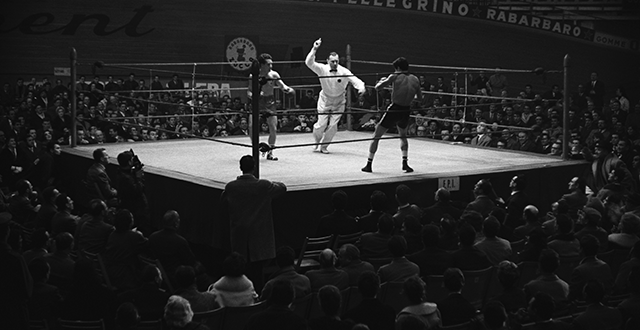News
Österreichpremiere von "The Memory of Justice"
Robert Newald, der Standard
Am Montag fand im Stadtkino, in Anwesenheit des Regisseurs Marcel Ophüls, die Österreichpremiere des Films "The Memory of Justice" aus dem Jahr 1976 statt. Der Film ist bis 4. Juni, bei freiem Eintritt, im Rahmen der Wiener Festwochen, zu sehen.
View images here
classics return to the screen at celluloid celebration
Steve Dollar, The Wall Street Journal
If digital technology has made old-fashioned 35mm movie exhibition obsolete, it is news to Jed Rapfogel. The film programmer at Anthology Film Archives in the East Village suggests that celluloid’s apparent sunset could also be a golden age—at least for New York audiences.
“Paradoxically, as digital is taking over and film is fading away, we’re getting these very beautiful prints from the studios and archives,” said Mr. Rapfogel. “You’re more aware of the beauty as you realize these prints have become rarer.”
Anthology shows why those films are worth saving, and savoring, in a continuing series it launches this weekend called “This Is Celluloid,” a showcase not only for 35mm—a format the venue screens regularly—but for some of the best-looking prints available. Those include classics, such as John Ford’s 1949 Technicolor Western “She Wore a Yellow Ribbon,” but also films that are rarely shown in any format, like Francis Ford Coppola’s monochrome reverie “Rumble Fish” and the forgotten English glam-rock musical “Never Too Young to Rock.”
“It’s just fun to have a context in which to show something like that,” said Mr. Rapfogel, who also booked such cinematic indulgences as John Boorman’s 1981 Arthurian epic “Excalibur.” “It flirts with ridiculousness,” he said. “but I find it sublime in the end.”
Several other New York film institutions regularly show 35mm prints, including the Film Society of Lincoln Center, Film Forum, BAMcinematek, Museum of the Moving Image and the Museum of Modern Art, which celebrates the centennial of Technicolor with a two-month series starting June 5. Even in suburban Yonkers, the Alamo Drafthouse multiplex offers 35mm shows of cult and classic films alongside summer blockbusters—a standard feature in many of the Texas-based chain’s theaters.
Preserving and showcasing physical film prints is a core mission for Anthology, which holds one of the world’s most extensive collections of avant-garde films on not just 35mm, but on 16mm, and Super-8mm film as well.
Their increasing rarity stems from the perishable nature of film stock and a lack of regard for preservation in the earlier decades of the form, Mr. Rapfogel said. Some half of all films made before 1950 have been lost, according to the Film Foundation, the nonprofit organization founded by Martin Scorcese to preserve and restore film. Enemies include extreme temperatures, humidity and improper storage; until 1952, film stock was nitrate-based, which made it a fire hazard, said Margaret Bodde, the foundation’s executive director.
“We’re losing that moment where everyone wanted everything to look perfect,” said Ms. Bodde. “Now there is a reappreciation. Even if a film print has flaws, it has this quality that’s hard to replicate in digital.”
Digital lacks the organic quality—the pulse—of film, Mr. Rapfogel said. “When you watch a film print, you are seeing a physical object with a certain amount of character and texture being transmuted into something on-screen.”
Some major contemporary filmmakers agree. Paul Thomas Anderson, Wes Anderson, Christopher Nolan and Quentin Tarantino all shoot on film. Mr. Scorsese has returned to it for his new feature “Silence.” J.J. Abrams is using film for the next phase of the “Star Wars” franchise. “There’s a sense of ‘let’s try to keep that as a choice,’ ” Ms. Bodde said.
“You get lulled into this reverie when you’re watching film that you never do with anything on digital, no matter how good it looks,” said David Spencer, senior curator at the film school of the University of North Carolina School of the Arts in Winston-Salem, N.C., where he oversees a print archive of 15,000 films.
The archive, which has ramped up its loan program in recent years, is lending Anthology its Technicolor prints of “Never Too Young to Rock” and the Fleischer brothers’ 1941 animated feature “Hoppity Goes to Town.” In the latter film, “there’s a jazz jitterbug sequence where the characters are dancing around after being electrocuted that is just phenomenal,” said Mr. Spencer. “The mid-1940s were ahead of their time.”
Gina Telaroli, a New York-based filmmaker, used to liken classic 35mm films to paintings. “Now I think the analogy of going to see a 35mm print is like going to see someone in concert,” she said. “If you love the Rolling Stones, they’re going to die soon, so you better go see them.”
That might seem dire, but Ms. Telaroli framed her thoughts as a cinephile mission statement: “We need to have a living culture of people that know what these films look like,” she said.
John Wayne, Joanne Dru and John Agar in ‘She Wore a Yellow Ribbon,’ part of the ‘This Is Celluloid’ series at Anthology Film Archives in the East Village. Photo: EVERETT COLLECTION
18 restored film gems to play at SIFF 2015
Moira Macdonald, The Seattle Times
Newly restored prints of “Rebel Without a Cause,” “The Apu Trilogy” and other classics will be shown at this year’s festival, in part due to the protective efforts of the Film Foundation.
“Why preserve?” asked filmmaker Martin Scorsese, in a 2013 lecture presented by the National Endowment for the Humanities. “Because we can’t know where we’re going unless we know where we’ve been — we can’t understand the future or the present until we have some sort of grappling with the past.”
Those thoughts led Scorsese, in 1990, to unite a group of filmmakers to form the Film Foundation, a nonprofit dedicated to protecting and preserving motion picture history. Twenty-five years later, the Film Foundation has helped to restore more than 600 rapidly deteriorating films, many of them classics. (“The Tales of Hoffmann,” which screened at Cinerama last month, was beautifully restored through the Film Foundation.) The Seattle International Film Festival will be showcasing a number of Film Foundation restorations in the next three weeks, in tribute to their organization’s pioneering work.
Margaret Bodde, the Film Foundation’s executive director, said last week that in 1990, an “urgent emergency” existed in the field of film preservation — archives, which held copies of rapidly degrading historic movies on nitrate film, lacked the funds and support to transfer them to more stable film stock. The Foundation acted as a bridge between the archives and the studios, who quickly realized that the burgeoning home video market gave them an incentive to preserve and stabilize classic films.
“It was a happy coincidence — that market emerged, and it was really a very compelling rationale for preservation,” said Bodde. “We had the ideological outreach that we were doing, but I think without the economic incentive, we wouldn’t have been able to be as successful at raising awareness and getting as many films restored and preserved.”
Now, the Film Foundation’s growth has spread worldwide, with a new World Cinema Project that has restored 24 films from Mexico, South America, Africa, Eastern Europe, the Middle East, and Central and Southeast Asia. Among these films are acclaimed African filmmaker Ousmane Sembène’s 1968 first feature, “Black Girl,” which screens at SIFF June 1 — just after the restoration’s world premiere at the Cannes Film Festival.
“With ‘Black Girl,’ we actually found the original negative,” said Bodde. As with many historic films, the process was something of a treasure hunt — “it turned out that the elements were held at an archive [in France] and people hadn’t remembered that it had been deposited there.”
“Black Girl” underwent a 4K digital restoration — a process through which the original negative is scanned and converted to a computer file. “It picks up every grain of visual content, and it transfers that into the digital realm,” said Bodde, who explained that technicians are then able to color correct, fix torn frames, and erase scratches and dirt. Many of these processes can be automated, making the system much more efficient than cleaning frame-by-frame by hand. The end result can then be transferred back to 35mm film, or converted to a digital presentation suitable for movie theaters (known as DCP), with the original safely stored.
1955’s “Rebel With a Cause,” screening in tribute to the late screenwriter Stewart Stern, also underwent a recent restoration through the Film Foundation. Though some may be surprised that such a well-known film would require such work, Bodde explained that director Nicholas Ray was working with a limited budget at the time.
“It’s iconic now, and obviously it’s one of the great Hollywood films that people think of as epitomizing the studio system, but when ‘Rebel’ was made, it was a low-budget film,” she said, noting that Ray used Eastman color stock, which faded easily, rather than the more expensive three-strip Technicolor. “You also had the popularity of the film, which meant that they were making prints off that negative left and right. It’s a double-edged sword of popularity and preservation — when pictures were big hits, you have more damage to the film.”
Other Film Foundation restorations in the festival include the 1940s thrillers “Caught” and “The Dark Mirror,” and the rarely seen 1932 gothic horror movie “The Old Dark House,” from director James Whale (“Frankenstein”). All three of these will screen in 35mm — an increasingly rare event in this digital age.
Ultimately, the goal of the foundation is to preserve film history for new generations, many of whom may experience these works on small screens — but an opportunity to view a restored work in a theater, as it was intended to be seen, is a rare treat.
“It’s communal,” said Bodde, of moviegoing. “That’s not replaceable when you’re watching something in the comfort of your own home. There’s nothing like experiencing a film with an audience and hearing where they’re laughing and what they’re responding to and what you’re responding to. It’s different and shared, at the same time.”
Archival films at SIFF
Film Foundation titles:
“Alyam, Alyam” (Morocco, 1978): SIFF screening TBA.
“Black Girl” (Senegal, 1968): 7 p.m. June 1, Harvard Exit.
“Caught” (USA, 1948): 8 p.m. May 28, Uptown
“The Color of the Pomegranites” (Armenia, 1969): 7 p.m. May 20, Harvard Exit
“The Dark Mirror” (USA, 1946): 6 p.m. May 28, Uptown
“The Old Dark House” (USA, 1932): 7 p.m. May 18, Egyptian
“Rebel Without a Cause” (USA, 1955): 4 p.m. May 31, Egyptian
“The Red Shoes” (U.K., 1948): 12:30 p.m. May 16, Egyptian
http://www.seattletimes.com/entertainment/movies/18-restored-film-gems-to-play-at-siff-2015/
Gucci backs film restoration for special 68th Cannes Film Festival presentation
Gucci celebrates its continued commitment to the preservation and restoration of classic cinema, through its ten-year collaboration with Martin Scorsese's The Film Foundation. This year will see the Italian fashion house's collaborative work with the foundation, revive a restoration of Luchino Visconti's Rocco e i suoi fratelli, originally made in 1960, at the annual Cannes Film Festival as part of the festival's 'Cannes Classics' programme.
Gucci was inspired to make a multi-million dollar commitment to The Film Foundation for the restoration of iconic and innovative films, ten years ago, thanks to a shared interest and appreciation of creative visionaries. Artistic filmmakers such as John Cassavetes, Sergio Leone and Federico Fellini are favourites of the luxury heritage fashion house that appreciates the bold and daring artistry and genre-redefining works of these directors and others like them.
The restoration of Rocco e i suoi fratelli, will debut at the Cannes Film Festival on May 17 after an introduction from Benicio Del Toro, who is an avid supporter of the continued work of The Film Foundation and Gucci: "There are so many great films from the past that have inspired me and continue to inform and fuel my work. It's important to support the preservation of these films so that future generations can experience their power and artistry. And Visconti was certainly one of the great cinematic visionaries," says Del Toro.
The 1960 film examines the effects that the industrial and economic boom (that was transforming Italy at that time,) had on the country, through following the eponimois Rocco and his brothers. It is the story of how this new world – represented by Milan city life –impacts a poor rural family. Martin Scorsese says: "Rocco is one of the most sumptuous black and white pictures I've ever seen: the images, shot by the great Giuseppe Rotunno, are pearly, elegant and lustrous – it's like a simultaneous continuation and development of neorealism. Thanks to Gucci and The Film Foundation and our friends at the Cineteca di Bologna, Luchino Visconti's masterpiece can be experienced once again in all its fearsome beauty and power."




